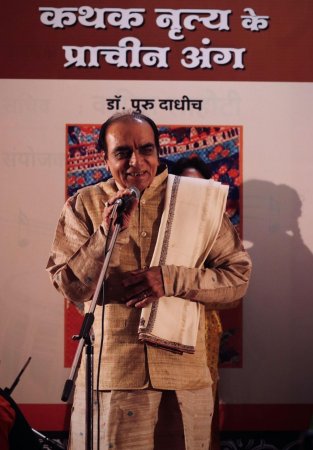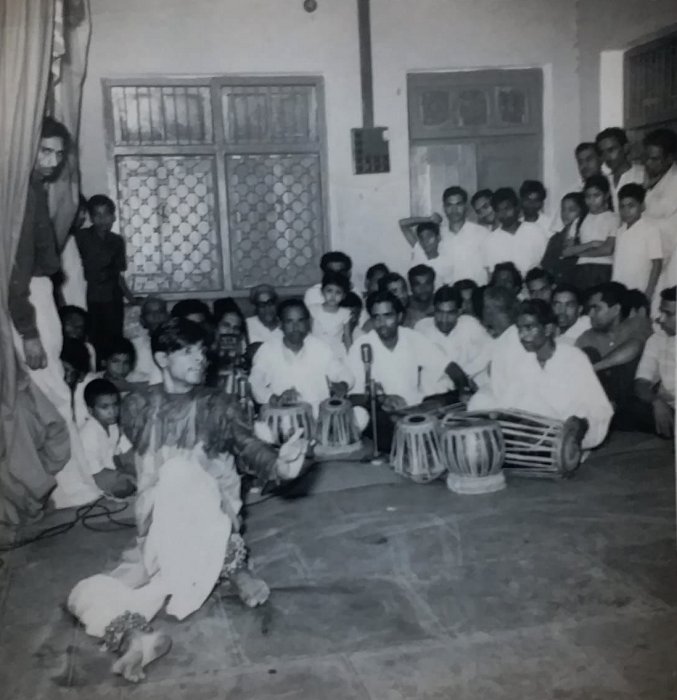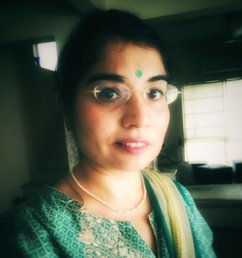 |
  |
 |
  |
Reviving a lost tradition of dance - Kiran Java e-mail: kiran@kiranjava.com November 21, 2021 A dance is deemed as an Indian classical dance when its theory and practice can be traced to the Natyashastra, a performing arts treatise dated to 200 B.C - 200 C.E. attributed to Sage Bharata. Bharatanatyam, Kathak, Kuchipudi, Odissi, Kathakali, Sattriya, Manipuri, and Mohiniyattam are recognized as classical dances by Sangeet Natak Akademi. Chhau is included in the list by the Ministry of Culture. While other classical dances have evolved their art form from the standpoint of dance treatises, it is no secret that Kathak in its current form is difficult to link with the practices stated in the Natyashastra, the very text that marks its classical status. As a result, tracing Kathak, the principal dance of northern India, has long been a source of debate among Kathak dance practitioners. To this end, Dr. Pt. Puru Dadheech recently presented a daring blueprint connecting Kathak classical dance to its texts. Dr. Dadheech, a Padma Shri, Sangeet Natak Akademi awardee, and Ministry of Culture Tagore National Fellow, has spent over 60 years researching, practicing, documenting, and teaching Kathak. According to him, the only way to reconcile Kathak dance with its theory is to research relevant dance texts from the medieval period, notably from the 11th through 19th centuries.  Dr. Puru Dadheech explaining the importance of Kathak Shastra Nritya attains an independent status Dr. Dadheech has studied over 25 dance texts in Sanskrit and various Indian languages, on which his dance research is based. 'Kathak Gharanas' may be 100 or 200 years old, he states, but Kathak is a sub-division of Indian communities that evolved over thousands of years. The ancient Kathak community was the original custodian of music, both vocal and instrumental. Kathaks were firstly musicians who then adopted the famous Kushilav tradition of communicating stories from the epics and puranic literature. He explains that the word Nritya, which means a combination of drama and pure dance, first appears in the Amarakosha of Amarasimha (dated 1st to 5th century C.E). Prior to this, the Natyashastra does not mention Nritya; instead defines drama and Nritta (pure dance movements). It is only later, in the medieval era, that Nritya became commonplace and achieved an independent status of its own. By the time of Sangeet Ratnakar (13th century C.E.), Nritya was classified as Margi (art regulated by strict rules and governed by a path) versus Deshi (art meant to please the heart of people). It is important to note that the texts designate Nritya to be performed by women. As a result, it is not surprising that the medieval period texts contain all the dance principles required for a Narthaki (female dancer) of the time. They include principles of Angik Abhinaya bhed (one of the four categories of histrionic representation) from the Natyashastra to which prayoga (applications) of the Acharyas of that time are appended. The ancient dance repertoire In treatises such as Sangeet Darpan (17th century) and Nartananirnaya (16th century) is found dance repertoire such as the specifics of Rang Bhoomi for a solo dancer, tuning of instruments, and the manner of invoking Lord Ganesh, traditions that can still be seen in Kathak today. The Kathak dancer should be aware that the Ganesh Vandana, Ganesh Stuti, and Ganesh Paran that form part of the Kathak repertoire have their origins in our ancient dance treatise. From the ancient texts, Dr. Dadheech has researched dance elements such as Pushpanjali (Poho Pajuri), Yavanika, Stuti, Bhoomi Pujan, Rang Devi Stuti, Nandi, and others to demonstrate and practically show how they can be adapted into Kathak dance today. His students and renowned Kathak dancers Dr. Piyush Raj, Dr. Sunil Sunkara, and Riddhi Mishra successfully showcased these on the Sangeet Natak Akademi, Ministry of Culture social media recently. Kathak is known for more freedom of movement and a more flexible repertoire, in comparison to other dance forms. So it is a surprise to see that in the case of Nandi or benediction in dance, the ancient texts clearly state the hand gestures for each word of the Nandi Shloka and the manner in which they are to be performed. After careful study of rare manuscripts, Dr. Dadheech cites Acharya Hari Vallabh's text as an example. He says the Nandi mentions forming two open Pataka hand gestures to denote the word Bhavatam (for all you people), Suchi hand gesture to denote Lord Shiva, Anjali hand gesture placed on the head to indicate Goddess Parvati, Chatur hand gesture on the heart to show the word beloved, a moving Hamsasya hand gesture near the face to symbolize su-sangeet (music), and so on. Kathak's technical vocabulary Dr. Dadheech has also discovered references to existing Kathak dance movements in ancient texts. These he claims form Kathak's technical vocabulary. What the texts describe as the movement of a candle flickering in a gentle breeze is the movement in Kathak performed during Thaat, which is technically referred to as Sulap in the texts. Sudhang is a distinguishing movement that is only performed in Kathak dance and is also clearly defined in the texts. The texts describe Tirap, a technical term for the diagonal walk that is famous for its ending in the traditional Gat Nikas dance, which is still performed today. These technical terms mentioned in the treatises must be revived. Dance on diverse Taal compositions is called Shabd Nritya in the texts. Shabd Nritya is defined as reciting the dance bols during the dance, tapping the feet to accentuate the words of the composition, and finishing with a spin. This element has developed the most in Kathak, according to Dr. Dadheech. Today, it can be seen in Kathak performances of Toda-Tukda. Dr. Dadheech is convinced that many more manuscripts containing dance related material and movements are yet to be discovered. To move this massive task forward, there is a severe need for ongoing surveys, tabulation, and research by the relevant ministries. Early life and education From a young age, Dr. Dadheech was fascinated by drawing and painting particularly dance sculptures. His quest to draw dance mudras led him to Kathak maestro Durga Prasad. His grandfather, Pt. Onkarlal Dadheech, taught him Sanskrit literature, drama, and religious texts such as the epics and puranic literature. He was only 14 years of age when he began choreographing dance dramas for school performances in Ujjain, expertly blending theory and practice. He learned Kathak from stalwarts Durga Prasad, Sunder Prasad, Narayan Prasad, and Shambhu Maharaj. At the age of 19, he gave a full Kathak performance at the launch of Durga Prasad's Kathak school in 1958.  Dr. Puru Dadheech showcasing Kathak classical dance in the late 1950s Dance was exclusively performed by courtesans at the time and was frowned upon in Malwa society. Dr. Dadheech went from street to street, showing ordinary people "classical dancing." He used to tell them that this is "classical dance," just as there is "classical music." He later earned a Ph.D. in Sanskrit Dramatics under the guidance of Natyashastra scholar Dr. Babulal Shukla Shastri. He also has an M.A. in Sanskrit Literature under the guidance of Dr. Shrinivas Rath (Rath Sahib), Professor of Sanskrit at Vikram University, Ujjain. He was additionally mentored by the legendary scholar poet Dr. Shiv Mangal Singh 'Suman'. Dr. Dadheech is also the first person to be awarded a Doctorate in Kathak dance (D.MUS). He was head of the dance department at Bhatkhande Hindustani Sangeet Mahavidyalaya, Lucknow where he developed the dance library and edited numerous research magazines. He created the first Kathak educational syllabus in 1961, which was implemented at the university level, bringing Kathak into the mainstream formal education system. Top 10 Kathak resources created by Dr. Puru Dadheech
 Kiran Java has graduated with a BSc. Marketing from Eastern Connecticut State, USA and has over 20 years of experience in PR in the Middle East. Currently, she is a curator-editor at Pushtimarg Studies. She has done her Diploma in Natyashastra with Kathak relevancy under Dr. Puru Dadheech at Bharata College. She is also learning Kathak from Dr. Pt. Nandkishore Kapote, studying Vallabh Vedanta from Mumbai University and pursuing a Master's degree in Journalism and Communication. Post your comments Pl provide your name and email id along with your comment. All appropriate comments posted with name and email id in the blog will be featured in the site. |